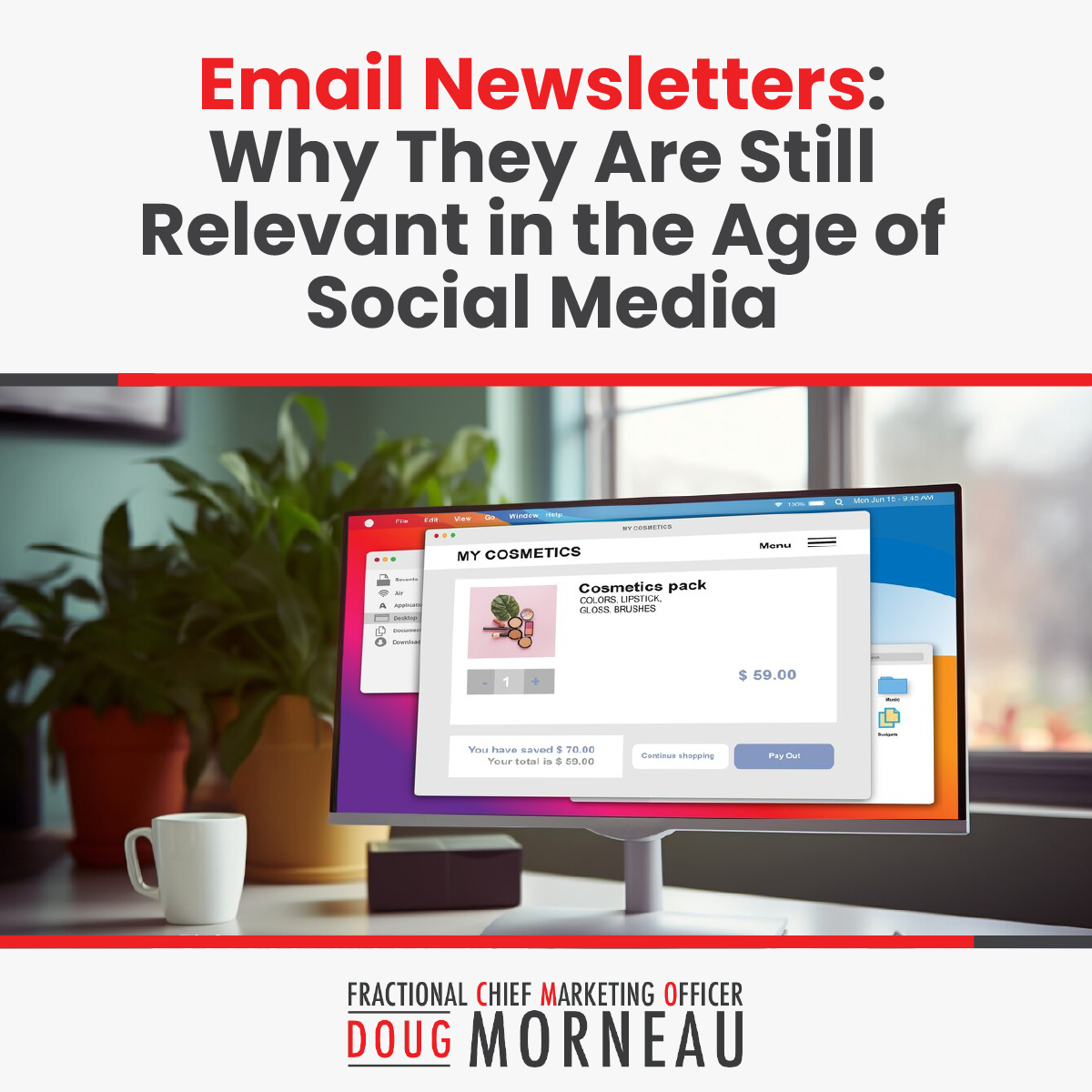Table of Contents
ToggleEmail Newsletters: Why They Are Still Relevant in the Age of Social Media
In the age of social media, where trends come and go at lightning speed, email newsletters stand out as a tried and true marketing tool that continues to deliver results. While social media platforms have their advantages, email newsletters offer a unique and valuable way to connect with your audience on a more personal level.
Many businesses and brands have turned to social media as their primary means of communication and engagement. However, relying solely on these platforms can be risky. Algorithms and news feed algorithms change frequently, impacting the reach and visibility of your content.
In contrast, email newsletters allow you to maintain direct contact with your subscribers, ensuring that your message reaches them without any intermediaries.
Furthermore, email newsletters offer a sense of exclusivity and provide an opportunity to nurture a loyal community. With personalization and targeted content, you can create a tailored experience for your subscribers, increasing engagement and ultimately driving conversions.
In summary, in the age of social media, email newsletters remain a relevant and effective marketing tool that enables you to build a loyal community and connect with your audience on a deeper level.
Benefits of using email newsletters for marketing
Email newsletters have been around for decades, and despite the rise of social media, they remain a powerful marketing tool for businesses of all sizes. Here are some reasons why email newsletters are still relevant in today’s digital landscape.
Firstly, email newsletters provide a direct line of communication with your audience. When someone subscribes to your newsletter, they are giving you permission to reach out to them directly in their inbox. This level of access is invaluable for building and nurturing relationships with your subscribers.
Secondly, email newsletters offer a more personal and intimate connection. Unlike social media posts that can get lost in a sea of updates, newsletters have a dedicated space in your subscribers’ inbox, where they can take the time to read and engage with your content. This personal touch allows you to create a stronger bond with your audience and establish trust.
Furthermore, email newsletters allow for targeted and personalized content. With the right email marketing tools, you can segment your subscribers based on their interests, demographics, or past interactions. This segmentation enables you to deliver highly relevant content that resonates with your audience and increases the chances of conversions.

Email newsletter statistics: Key insights and trends
Using email newsletters as part of your marketing strategy can yield several benefits for your business.
Let’s explore some of the key advantages.
1. Higher engagement: Compared to social media platforms, where users are bombarded with a constant stream of content, email newsletters provide a less cluttered environment. This allows your message to stand out and increases the likelihood of engagement from your subscribers.
2. Increased brand awareness: Regularly sending newsletters to your subscribers helps to keep your brand top of mind. By consistently delivering valuable content, you can establish your expertise and build brand recognition.
3. Improved customer retention: Email newsletters serve as a reminder to your existing customers about the value you provide. By nurturing these relationships through informative and engaging content, you can increase customer loyalty and reduce churn.
4. Drive traffic to your website: Including links to your website or blog in your newsletters can drive traffic and increase engagement on your site. This can lead to higher conversion rates and ultimately boost your sales.
5. Measurable results: Email marketing platforms provide detailed analytics that allow you to track the performance of your newsletters. This data can help you optimize your campaigns and make data-driven decisions to achieve better results.
Crafting an effective email newsletter strategy
To understand the impact and relevance of email newsletters, let’s take a look at some key statistics and trends in the industry.
1. According to a study by the DMA, the average return on investment (ROI) for email marketing is $42 for every $1 spent. This impressive ROI showcases the effectiveness of email newsletters as a marketing tool.
2. Personalized subject lines can increase email open rates by 50%, as reported by HubSpot. This emphasizes the importance of customization and targeting in your email newsletter strategy.
3. Mobile optimization is crucial. With over 60% of emails being opened on mobile devices, ensuring that your newsletters are mobile-friendly is essential for engaging your audience.
4. Automation and triggered emails can significantly impact your conversion rates. Campaign Monitor reports that automated emails generate 320% more revenue than non-automated emails.

Building your email subscriber list
To leverage the power of email newsletters, it’s essential to have a well-defined strategy in place. Here are some key steps to consider when crafting your email newsletter strategy.
Building Your Email Subscriber List
The success of your email newsletter campaign starts with a quality subscriber list. Here are some strategies to grow your list:
1. Opt-in forms on your website: Place opt-in forms strategically on your website to capture visitors’ email addresses. Offer incentives such as exclusive content or discounts to encourage sign-ups.
2. Social media promotion: Leverage your social media platforms to promote your newsletter and encourage followers to subscribe. Use eye-catching visuals and compelling copy to grab their attention.
3. Content upgrades: Offer valuable content upgrades, such as e-books or checklists, that visitors can access by providing their email address. This approach incentivizes sign-ups and allows you to gather leads.
Designing Engaging Email Newsletter Templates
The design of your email newsletter plays a crucial role in capturing the attention of your subscribers.
Here are some best practices for designing engaging templates:
1. Keep it clean and visually appealing: Use a clean and professional design that aligns with your brand. Incorporate eye-catching visuals, clear headings, and a balanced layout to make your newsletter visually appealing.
2. Ensure mobile responsiveness: With the majority of emails being opened on mobile devices, it’s crucial to optimize your templates for mobile viewing. Test your newsletters on various devices and email clients to ensure a seamless experience.
3. Include clear call-to-action (CTA): Every newsletter should have a clear CTA that leads your subscribers to take the desired action. Use compelling copy and design elements to draw attention to your CTA.

Writing Compelling Newsletter Content
The content you include in your email newsletters will determine their effectiveness and impact. Here are some tips for crafting compelling newsletter content:
1. Know your audience: Understand the needs, interests, and pain points of your subscribers. Tailor your content to address their specific challenges and offer valuable solutions.
2. Use captivating subject lines: Grab your subscribers’ attention with compelling subject lines that entice them to open your emails. Personalization and curiosity can be effective tactics.
3. Keep it concise and scannable: People skim through emails, so make sure your content is easy to scan. Use subheadings, bullet points, and short paragraphs to make your newsletter more digestible.
4. Provide valuable content: Your newsletters should offer something of value to your subscribers, whether it’s educational resources, exclusive promotions, or industry insights. Focus on providing content that keeps your audience engaged and encourages them to take action.
Designing engaging email newsletter templates
To ensure the success of your email newsletter campaigns, it’s crucial to analyze their performance and make data-driven optimizations.
Here are some steps to consider:
1. Track key metrics: Monitor metrics such as open rates, click-through rates, conversion rates, and unsubscribe rates to gauge the effectiveness of your newsletters. Identify trends and areas for improvement.
2. A/B testing: Experiment with different subject lines, content formats, and CTAs to identify what resonates best with your audience. A/B testing allows you to optimize your newsletters based on actual data.
3. Segmentation and personalization: Use the data you gather to segment your subscribers and personalize your content. Tailoring your newsletters to specific segments can significantly impact engagement and conversions.
4. Continuous improvement: Regularly review and analyze your email newsletter campaigns. Look for areas where you can improve and iterate on your strategies to achieve better results over time.
Writing compelling email newsletter content
In conclusion, email newsletters remain a relevant and effective marketing tool in the age of social media. They provide a direct line of communication, foster personal connections, and offer targeted and personalized content. With the right strategy and optimization, email newsletters can drive engagement, increase brand awareness, and ultimately lead to conversions.
While social media has its advantages, relying solely on these platforms can be risky due to algorithm changes and reduced visibility. Email newsletters provide a more reliable way to connect with your audience and maintain control over your message.
As the digital marketing landscape continues to evolve, email newsletters will evolve as well. By adapting to new technologies and trends, such as automation, personalization, and mobile optimization, businesses can continue to leverage the power of email newsletters to engage their audience and drive business growth.
So, don’t overlook the power of email newsletters. Embrace them as a valuable marketing tool and unlock the potential they hold in building a loyal community and connecting with your audience on a deeper level.

Analyzing and optimizing your email newsletter campaigns
When it comes to email newsletters, the content you deliver plays a crucial role in capturing and retaining your audience’s attention. To create compelling newsletter content, you need to consider a few key factors.
First, it’s important to understand your target audience and their needs. What are their pain points? What kind of information or value can you provide to address those pain points? By understanding your audience’s motivations, you can create content that resonates with them and keeps them coming back for more.
Second, make sure your content is visually appealing. Use eye-catching images, videos, and graphics to break up text and make your newsletters visually engaging. Remember to optimize your images for faster loading times, as slow-loading newsletters can lead to high bounce rates.
Lastly, keep your content concise and easily scannable. People receive countless emails every day, so it’s crucial to make your newsletters skimmable. Use bullet points, subheadings, and short paragraphs to make your content easy to consume. Include a clear call to action that prompts readers to take the desired action, whether it’s making a purchase, signing up for an event, or sharing your newsletter with others.
By following these guidelines, you can create compelling newsletter content that keeps your subscribers engaged and eager to open your emails.
Conclusion: The future of email newsletters in the digital marketing landscape
Once you have started sending out email newsletters, it’s important to track and analyze their performance to optimize your campaigns. Here are some key metrics to consider:
1. Open rates: This metric measures the percentage of subscribers who open your emails. A low open rate may indicate that your subject lines are not compelling enough or that your emails are not reaching the desired inbox. Experiment with different subject lines and segment your email list to deliver more targeted content.
2. Click-through rates (CTR): CTR measures how many subscribers clicked on a link within your email. It indicates the effectiveness of your call to action and the relevance of your content. To improve CTR, make sure your links are prominently displayed and use strong, actionable language to drive clicks.
3. Conversion rates: Conversion rates measure the percentage of subscribers who take the desired action after clicking through your email. This could be making a purchase, signing up for a webinar, or downloading a resource. To improve conversion rates, ensure that your landing pages are optimized for conversions and that your call to action is clear and compelling.
4. Unsubscribe rates: While it’s natural to see some unsubscribes, a high unsubscribe rate may indicate that your content is not meeting the expectations of your subscribers. Monitor this metric closely and use feedback to improve your newsletters. In addition to tracking these metrics, consider conducting A/B testing to optimize various elements of your email newsletters, such as subject lines, content length, and design. By continuously analyzing and optimizing your email newsletter campaigns, you can ensure that your messages are resonating with your audience and driving the desired results.
FAQs for “Email Newsletters: Why They Are Still Relevant in the Age of Social Media”
Q1: Why are email newsletters still relevant in the age of social media?
A1: Email newsletters remain relevant because they provide a direct and reliable communication channel with subscribers. Unlike social media, newsletters allow businesses to maintain control over their message without being affected by frequent algorithm changes.
Q2: What are the benefits of using email newsletters for marketing?
A2: Benefits of using email newsletters include:
- Direct communication with the audience
- Personal and intimate connection
- Targeted and personalized content
- Higher engagement in a less cluttered environment
- Increased brand awareness and improved customer retention
Q3: What key insights and trends are associated with email newsletter statistics?
A3: Key insights and trends include:
- Average ROI for email marketing is $42 for every $1 spent.
- Personalized subject lines can increase email open rates by 50%.
- Over 60% of emails are opened on mobile devices, emphasizing the importance of mobile optimization.
- Automation and triggered emails generate 320% more revenue than non-automated emails.
Q4: How can businesses build their email subscriber list effectively?
A4: Strategies to build an email subscriber list include:
- Opt-in forms on the website with incentives
- Social media promotion with eye-catching visuals
- Offering content upgrades such as e-books
- Designing engaging email newsletter templates
Q5: What are best practices for designing engaging email newsletter templates?
A5: Best practices for designing engaging templates include:
- Keeping it clean and visually appealing
- Ensuring mobile responsiveness
- Including a clear call-to-action (CTA)
Q6: How can businesses craft compelling email newsletter content?
A6: Tips for crafting compelling content include:
- Understanding the target audience’s needs and pain points
- Using visually appealing elements like images and videos
- Keeping content concise and easily scannable
- Including a clear call-to-action (CTA)
Q7: What steps should businesses take to analyze and optimize their email newsletter campaigns?
A7: Steps to analyze and optimize email newsletter campaigns include:
- Tracking key metrics (open rates, CTR, conversion rates, unsubscribe rates)
- Conducting A/B testing for subject lines, content, and design
- Segmenting the email list for targeted content
- Continuous improvement based on analysis and feedback
Q8: Why is it important to track metrics like open rates, click-through rates, and conversion rates for email newsletters?
A8: Tracking metrics like open rates, click-through rates, and conversion rates is crucial because they provide insights into the effectiveness of email newsletters. These metrics help businesses understand subscriber engagement, the impact of content, and areas for improvement in their campaigns.
Q9: How can businesses ensure the success of their email newsletter campaigns in the long run?
A9: Businesses can ensure the success of their email newsletter campaigns by:
- Constantly analyzing and optimizing campaigns based on key metrics.
- Conducting A/B testing to refine various elements of newsletters.
- Adapting to new technologies and trends, such as automation and personalization.
- Maintaining a well-defined strategy and staying adaptable to changes in the digital marketing landscape.




